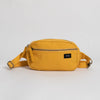The summer heat can be uncomfortable, but when did it ever stop us from going on a hike? The only rule of thumb is to be well-prepared for the trip and high temperatures. Read on for five important tips that will help you and your family have a fun and safe hiking adventure this summer!
Ready Sunblock Essentials— Sunscreen & Hat
The UV rays of the sun can damage the skin's outermost layer, causing problems like photoaging, wrinkles, freckles, age spots, etc. The delicate skin on the face and neck is particularly vulnerable to harmful UV rays. Apply high-SPF sunscreen for all exposed skin, including your arms, neck, and legs before heading out. Reapply, if necessary. You may also want to put on a hat for extra protection- pick a sun hat or any hat with a wide brim to shield your face. You can organize your sunscreen, bug spray and other essentials in a makeup bag that can go inside your sustainable backpack.
Carry A Suitable Backpack
Get the right backpack for your short hike or a day trek to carry your belongings - whether that is a small mini backpack or a regular size everyday backpack. Look out for features like multiple compartments, laptop sleeves, or water bottle pockets, depending on your needs. Give your decision some thought to make the best choice possible. Ensure the bag has enough storage space, fits your organizational style, and other necessary functionalities for the highest level of comfort. If it is a short hike and you won't be needing a backpack, give a canvas fanny pack a try.
Early Morning Head Start
Starting a hike late means more hours under the harsh sun. Early morning hikes over afternoon hikes are always smarter because you can explore nature in cooler temperatures before the sun starts to blaze. This will also leave you with ample hours to relax and recuperate your mind and body afterwards.
Take Heat Impact Precautions
Summer heat can compromise the risks of physical activities. Understanding the symptoms can spare harmful consequences like heat stress, heat exhaustion, and heat stroke. The symptoms can include breathlessness, headaches, muscle cramps, etc., which are usually a sign of heat stress and exhaustion that comes before a heat stroke. If you start to feel any of these symptoms, find some shady areas to rest and drop your body temperature. Ignoring the physical signs can result in heat stroke, which will require professional medical help. It won't be a great hike day if you have to run to the hospital mid-trip. So, be aware and take precautions to avoid such situations.
Always Go for a Hike Prepared
Finally, we want to draw attention to how crucial it is to go prepared for a hike! While it can work out sometimes, impromptu hikes can be unsafe owing to natural hazards and poor decision-making. Assemble your hike kit right, including sun protection items, water, electrolytes, a map, food, etc. Keep in mind that dehydration can be the main culprit throughout the hike, making the body more vulnerable to heat. Hydrate well before beginning the hike— drink ample water the day before the hike and rehydrate every interval on the hike day!
Happy trails!
Related blog:





